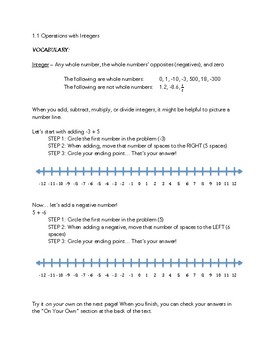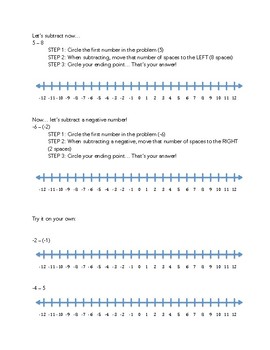Adding and Subtracting Rational Numbers Skills & Intervention Work
Manske's Math Store
18 Followers
Resource Type
Standards
CCSS5.NBT.A.3
CCSS5.NF.A.1
CCSS5.NF.A.2
CCSS6.NS.C.5
CCSS6.NS.C.6a
Formats Included
- PDF
Pages
40 pages
Manske's Math Store
18 Followers
Also included in
- Multiple middle school math products are bundled to give you lots of standards-aligned resources for one great price! This bundle includes 6th, 7th, and 8th grade math assignments, mini-lessons, quizzes, exit slips, a real world rational numbers project, warm-ups, and skills work. Get these 15 produPrice $45.00Original Price $63.50Save $18.50
- Assess your students' knowledge about operating with rational numbers. Students must operate with integers and other rational numbers. Use these resources as assignments, assessments, or as intervention skills work. Answer keys included!Price $15.00Original Price $20.00Save $5.00
Description
This resource can be used by teachers OR by parents to support students in math instruction. Explanations, step-by-step examples, and independent work are all provided to help students acquire basic understanding of adding and subtracting rational numbers (as well as pre-requisite skills). ANSWER KEY INCLUDED!
Total Pages
40 pages
Answer Key
Included
Teaching Duration
N/A
Report this resource to TPT
Reported resources will be reviewed by our team. Report this resource to let us know if this resource violates TPT’s content guidelines.
Standards
to see state-specific standards (only available in the US).
CCSS5.NBT.A.3
Read, write, and compare decimals to thousandths.
CCSS5.NF.A.1
Add and subtract fractions with unlike denominators (including mixed numbers) by replacing given fractions with equivalent fractions in such a way as to produce an equivalent sum or difference of fractions with like denominators. For example, 2/3 + 5/4 = 8/12 + 15/12 = 23/12. (In general, 𝘢/𝘣 + 𝘤/𝘥 = (𝘢𝘥 + 𝘣𝘤)/𝘣𝘥.)
CCSS5.NF.A.2
Solve word problems involving addition and subtraction of fractions referring to the same whole, including cases of unlike denominators, e.g., by using visual fraction models or equations to represent the problem. Use benchmark fractions and number sense of fractions to estimate mentally and assess the reasonableness of answers. For example, recognize an incorrect result 2/5 + 1/2 = 3/7, by observing that 3/7 < 1/2.
CCSS6.NS.C.5
Understand that positive and negative numbers are used together to describe quantities having opposite directions or values (e.g., temperature above/below zero, elevation above/below sea level, credits/debits, positive/negative electric charge); use positive and negative numbers to represent quantities in real-world contexts, explaining the meaning of 0 in each situation.
CCSS6.NS.C.6a
Recognize opposite signs of numbers as indicating locations on opposite sides of 0 on the number line; recognize that the opposite of the opposite of a number is the number itself, e.g., -(-3) = 3, and that 0 is its own opposite.







